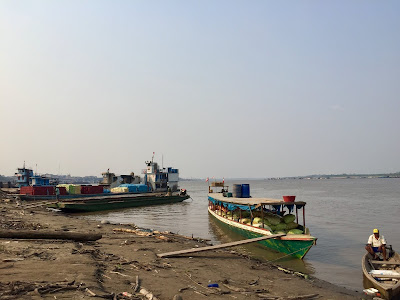Gabriela Carbó's Experience with "Bathroom Talk"
Written by Gabriela Carbó – UNICEF, Peru
Sticky, sweaty, smoggy – those were my first impressions as I descended the steps of the plane into the city of Pucallpa in the Amazonian jungle. The air was filled with the sound of motorbikes, which stood ready to sweep locals and travelers alike into the heart of the city. Pucallpa—a city known for its timber industry—rests on the left bank of the Ucayali River. The river is home to roughly 150 small Shipibo-Conibo communities; the Shipibo-Conibo are an indigenous ethnic group representing almost 8% of the indigenous registered population of Peru.
 I had arrived in Lima one month earlier to begin my six-month placement with UNICEF. I was working on Environment and Sustainability and up to that point, my placement had consisted of desk research on Peruvian climate and environment laws at the national, regional and local level. I was excited to travel to the field, even though I was dealing with my first case of severe food poisoning. I could not miss the opportunity. I made a mental note: Imodium© is a trusted ally and it will forever stay close at hand.
I had arrived in Lima one month earlier to begin my six-month placement with UNICEF. I was working on Environment and Sustainability and up to that point, my placement had consisted of desk research on Peruvian climate and environment laws at the national, regional and local level. I was excited to travel to the field, even though I was dealing with my first case of severe food poisoning. I could not miss the opportunity. I made a mental note: Imodium© is a trusted ally and it will forever stay close at hand.
The next morning, we boarded a riverboat and traveled for three hours deep into the jungle to visit the community of Nueva Betania. UNICEF has been working with the community to install dry ecological bathrooms. These are wooden boxes made from local materials that need neither water nor pipes to function; instead, sawdust (which is free or affordable in this timber intensive area) is used to dry out the excrement. Many ecological bathrooms have also been equipped with a rainwater collection system for personal hygiene.
The relationship between children’s rights and environmental sustainability is not always clear. Although the idea that we must preserve the quality of the environment for future generations is widely understood, the fact that e
nvironmental degradation violates the rights of current children is not as often addressed. Simply put, every child is born with the right to survive and develop healthily to their fullest potential.[1] There are several rights that need to be fulfilled to reach this overarching objective, including the child’s basic rights to adequate food and water[2] and the right to safe and secure housing[3] which are all consistently undermined by environmental degradation and climate change.
Ecological bathrooms are one way to provide sustainable, contamination-free waste management while also having a positive environmental effect (e.g., the waste mixed with sawdust produces compost to improve crops). Perhaps most importantly, these bathrooms are helping to fulfill children’s right to survive and develop healthily to their fullest potential. By limiting open defecation and giving children and their families a clean and dignified toilet, there is a decrease in pollution of water resources, soil, and vegetation, and as such, a decrease in the presence of flies and mosquitoes. With access to clean food and water and fewer mosquito born-illnesses, children are healthier and less susceptible to anemia, constant diarrhea, and gastrointestinal diseases.
 Indigenous children also have the right to learn about and practice their own culture, language, and religion.[4] As I walked through the community of Nueva Betania, I was greeted by beautiful wall art decorating the houses; the art often depicted spiritual rituals, local animals and plants. It was a helpful reminder of the deep connection that many indigenous cultures have with their environment, and how viewing environmental sustainability through the lens of children’s rights will better allow us to address the social repercussions of environmental degradation.
Indigenous children also have the right to learn about and practice their own culture, language, and religion.[4] As I walked through the community of Nueva Betania, I was greeted by beautiful wall art decorating the houses; the art often depicted spiritual rituals, local animals and plants. It was a helpful reminder of the deep connection that many indigenous cultures have with their environment, and how viewing environmental sustainability through the lens of children’s rights will better allow us to address the social repercussions of environmental degradation.
As I returned to Lima, aching for a cooler climate and respite from my gastrointestinal distress, I thought about the children and the ecological bathrooms. The importance of having a safe, clean and accessible bathroom was made ever clearer in my head. During the months that followed, the community of Nueva Betania has remained top of mind as I’ve worked to define and strengthen the link between children’s rights and environmental sustainability as well as assisting in the development of UNICEF’s plan to bring children’s rights to the forefront of the conversation on environment-related matters in Peru.


Comments
Post a Comment